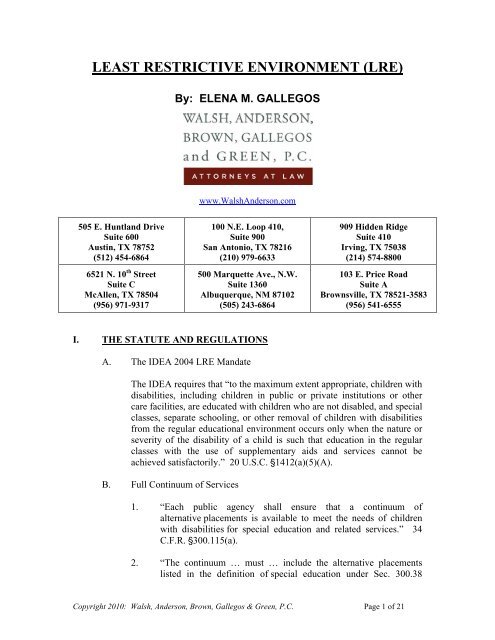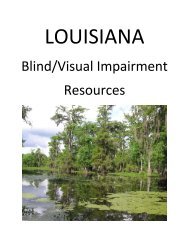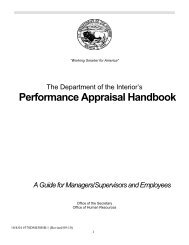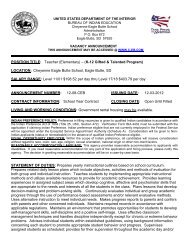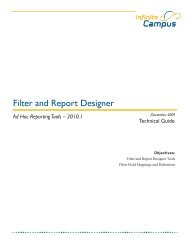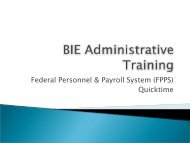LEAST RESTRICTIVE ENVIRONMENT (LRE)
LEAST RESTRICTIVE ENVIRONMENT (LRE)
LEAST RESTRICTIVE ENVIRONMENT (LRE)
- No tags were found...
You also want an ePaper? Increase the reach of your titles
YUMPU automatically turns print PDFs into web optimized ePapers that Google loves.
<strong>LEAST</strong> <strong>RESTRICTIVE</strong> <strong>ENVIRONMENT</strong> (<strong>LRE</strong>)By: ELENA M. GALLEGOSwww.WalshAnderson.com505 E. Huntland DriveSuite 600Austin, TX 78752(512) 454-68646521 N. 10 th StreetSuite CMcAllen, TX 78504(956) 971-9317100 N.E. Loop 410,Suite 900San Antonio, TX 78216(210) 979-6633500 Marquette Ave., N.W.Suite 1360Albuquerque, NM 87102(505) 243-6864909 Hidden RidgeSuite 410Irving, TX 75038(214) 574-8800103 E. Price RoadSuite ABrownsville, TX 78521-3583(956) 541-6555I. THE STATUTE AND REGULATIONSA. The IDEA 2004 <strong>LRE</strong> MandateThe IDEA requires that “to the maximum extent appropriate, children withdisabilities, including children in public or private institutions or othercare facilities, are educated with children who are not disabled, and specialclasses, separate schooling, or other removal of children with disabilitiesfrom the regular educational environment occurs only when the nature orseverity of the disability of a child is such that education in the regularclasses with the use of supplementary aids and services cannot beachieved satisfactorily.” 20 U.S.C. '1412(a)(5)(A).B. Full Continuum of Services1. “Each public agency shall ensure that a continuum ofalternative placements is available to meet the needs of childrenwith disabilities for special education and related services.” 34C.F.R. '300.115(a).2. “The continuum … must … include the alternative placementslisted in the definition of special education under Sec. 300.38Copyright 2010: Walsh, Anderson, Brown, Gallegos & Green, P.C. Page 1 of 21
(instruction in regular classes, special classes, special schools,home instruction, and instruction in hospitals and institutions).” 34C.F.R. '300.115(b)(1).3. “The continuum … must … make provision for supplementaryservices (such as resource room or itinerant instruction) to beprovided in conjunction with regular class placement. 34 C.F.R.'300.115(b)(2).C. Making the Determination1. “In determining the educational placement of a child with adisability, including a preschool child with a disability, each publicagency must ensure that … the placement decision is based on thechild’s IEP.” 34 C.F.R. '300.116(b)(2).2. “In determining the educational placement of a child with adisability, including a preschool child with a disability, each publicagency must ensure that … in selecting the <strong>LRE</strong>, consideration isgiven to any potential harmful effect on the child or on the qualityof services that he or she needs. 34 C.F.R. '300.116(d).3. “In determining the educational placement of a child with adisability, including a preschool child with a disability, each publicagency must ensure that … a child with a disability is not removedfrom education in age-appropriate regular classrooms solelybecause of needed modifications in the general curriculum.” 34C.F.R. '300.116(e).4. “As used in this part, the term individualized education program orIEP means a written statement for each child with a disability …that must include ... a statement of the special education andrelated services and supplementary aids and services, based onpeer-reviewed research to the extent practicable, to be provided tothe child, or on behalf of the child, and a statement of the programmodifications or supports for school personnel that will beprovided for the child—(i) To advance appropriately toward attaining the annualgoals;(ii) To be involved in and make progress in the generalcurriculum in accordance with paragraph (a)(1) of thissection, and to participate in extracurricular and othernonacademic activities; andCopyright 2010: Walsh, Anderson, Brown, Gallegos & Green, P.C. Page 2 of 21
(iii)To be educated and participate with other childrenwith disabilities and nondisabled children in the activitiesdescribed in this section.” 34 C.F.R. '300.320(a)(4).D. Ensuring the Right Decision and Justifying the Determination1. “As used in this part, the term individualized education program orIEP means a written statement for each child with a disability …that must include ... an explanation of the extent, if any, to whichthe child will not participate with nondisabled children in theregular class and in the activities described in paragraph (a)(4) ofthis section. 34 C.F.R. '300.320(a)(5).2. “Each public agency must ensure that … to the maximum extentappropriate, children with disabilities, including children in publicor private institutions or other care facilities, are educated withchildren who are nondisabled.” 34 C.F.R. '300.114(a)(2)(i).3. “Each public agency must ensure that … special classes, separateschooling, or other removal of children with disabilities from theregular educational environment occurs only if the nature orseverity of the disability is such that education in regular classeswith the use of supplementary aids and services cannot be achievedsatisfactorily.” 34 C.F.R. '300.114(a)(2)(ii).4. “In providing or arranging for the provision of nonacademicand extracurricular services and activities, including meals,recess periods, and the services and activities set forth in Sec.300.306, each public agency shall ensure that each child with adisability participates with nondisabled children in those servicesand activities to the maximum extent appropriate to the needs ofthat child.” 34 C.F.R. '300.553.5. “Each public agency shall take steps to provide nonacademicand extracurricular services and activities in the manner necessaryto afford children with disabilities an equal opportunity forparticipation in those services and activities.” 34 C.F.R.'300.306(a).Copyright 2010: Walsh, Anderson, Brown, Gallegos & Green, P.C. Page 3 of 21
II.THE LEADING CASES ON <strong>LEAST</strong> <strong>RESTRICTIVE</strong> <strong>ENVIRONMENT</strong>A. Sixth Circuit 1 : Roncker v. Walter, 700 F.2d 1058 (6th Cir. 1983); cert.denied, 464 U.S. 864, 104 S.Ct. 196, 78 L.Ed.2d 171 (1983).Facts: Neill Roncker is a nine year old severely mentally retarded student.He also suffers from seizures. Due to his level of cognitive functioning, herequires constant supervision to ensure his safety. Neill is not considereddangerous. Following a period of attendance on a campus that allowed forcontact with nondisabled students, the school district proposed aplacement in an entirely segregated county school. The school districtstaff believed that this environment would be academically superior forNeill. During the pendency of the dispute, Neill began attending a classfor severely retarded students on a regular elementary school campuswhere he had limited opportunities during lunch, gym, and recess tointeract with nondisabled peers. At trial, the parties agreed that Neillshould not be instructed in a regular classroom setting. Instead, thedispute was narrowly tailored to the issue of opportunity to have contactwith nondisabled peers.Standard: “In a case where the segregated facility is considered superior,the court should determine whether the services which make thatplacement superior could be feasibly provided in a non-segregated setting.If they can, the placement in the segregated school would be inappropriateunder the Act.”Factors:1. Did the student make progress in the integrated setting? If thestudent did not make progress, were there additional serviceswhich would have improved his performance?2. Compare the benefits of regular and special education. Asegregated placement is appropriate if any marginal benefitsreceived from mainstreaming are far outweighed by the benefitsgained from services which could not feasibly be provided in thenon-segregated setting.3. Is the student disruptive in the non-segregated setting?4. Cost is a proper factor to consider since excessive spending on onedisabled child deprives other disabled children. Cost is no defenseif the school district failed to use its funds to provide a propercontinuum of alternative placements for disabled children.1 The Sixth Circuit Court of Appeals includes the states of Kentucky, Michigan, Ohio, and Tennessee.Copyright 2010: Walsh, Anderson, Brown, Gallegos & Green, P.C. Page 4 of 21
Result: Remanded to the district court to apply the above standard.B. Eighth Circuit 2 : A.W. v. Northwest R-1 School District, 813 F.2d 158 (8 thCir. 1987); cert. denied, 484 U.S. 847, 108 S.Ct. 144, 98 L.Ed.2d 100(1987).Standard:Roncker.The Eighth Circuit adopted the Sixth Circuit standard inC. Fourth Circuit 3 : DeVries v. Fairfax County School Bd., 882 F.2d 876 (4 thCir. 1989).Facts: Michael is a seventeen year old autistic student. Prior to thisdispute, Michael had been attending a private day school for disabledstudents. His mother sought placement for Michael at his home highschool campus. After first recommending continued placement at theprivate day school, the district recommended a segregated vocationalcenter, thirteen miles from home, and located in a regular high schoolcampus. His mother challenges the recommendation of the school districtto place Michael in the vocational center. Both the due process hearingofficer and review officer affirmed the school district’s recommendedplacement. The district court affirmed.Standard: Fourth Circuit adopts Sixth Circuit standard in Roncker.Results: Fourth Circuit upholds placement at Vocational Center, affirmsdistrict court’s comparison of the two placement options. There was noappropriate peer group academically, socially or vocationally for Michaelat his home high school (“Annandale”). Even with an aide to assist him incomprehending and in communicating with teachers and students, thecourt found that “Michael would simply be monitoring classes” withnonhandicapped students at Annandale.” Michael’s disability would makeit difficult for him to bridge the “disparity in cognitive levels” betweenhim and the other students, he would glean little from the lectures, and hisindividualized work would be at a much lower level than his classmates.In contrast, the South County Vocational Center, located within a publichigh school, would provide a structured program with the one-to-oneinstruction that Michael requires, including appropriate instruction inacademic subjects, vocational and social skills, community-based workexperiences, and access to all the programs and facilities of the public highschool.2 The Eighth Circuit Court of Appeals includes the states of Arkansas, Iowa, Minnesota, Missouri,Nebraska, North Dakota, and South Dakota.3 The Fourth Circuit Court of Appeals includes the states of Maryland, North Carolina, Virginia,Washington D.C., West Virginia, and South Carolina.Copyright 2010: Walsh, Anderson, Brown, Gallegos & Green, P.C. Page 5 of 21
D. Fifth Circuit 4 : Daniel R.R. v. SBOE, 874 F.2d 1036 (5th Cir. 1989).Facts: Daniel R. was a child with mental retardation and a speechimpairment. In 1985, his parents enrolled him in the district’s half-dayspecial education Early Childhood Program. Before the next year began,his mother requested placement for him in a half-day regular educationpre-kindergarten class so he could interact with children withoutdisabilities. The district agreed to enroll Daniel in the half-day prekindergartenclass as well as the half-day Early Childhood class.However, Daniel required “constant, individual attention” from the regulareducation teacher and aide in order to participate in the pre-kindergartenclass, and he was unable to master any of the skills taught as part of theregular curriculum. In November, the ARD committee proposed a revisedIEP under which Daniel would attend only the special education classwhile interacting with nonhandicapped children at recess and at lunch.Daniel’s parents challenged this decision in a due process hearing, but theschool district prevailed there and in federal court. The Fifth Circuitaffirmed, and in doing so it established a standard along with five factorsto consider when determining <strong>LRE</strong>.Standard (Two-Part Test):1. Ask whether education in the regular classroom, with the use ofsupplemental aids and services, can be achieved satisfactorily.2. If the answer is “no,” and the school intends to provide specialeducation or to remove the child from regular education, askwhether the school has mainstreamed the child to the maximumextent appropriateFactors to consider:1. Has the district taken steps to accommodate the child withdisabilities in regular education?“The Act requires states to provide supplementary aids andservices and to modify the regular education program when theymainstream handicapped children.”“If the state has made no effort to take such accommodating steps,our inquiry ends, for the state is in violation of the Act's expressmandate to supplement and modify regular education.”4 The Fifth Circuit Court of Appeals includes the states of Louisiana, Mississippi, and Texas.Copyright 2010: Walsh, Anderson, Brown, Gallegos & Green, P.C. Page 6 of 21
2. Were these efforts sufficient or token?“The Act does not permit states to make mere token gestures toaccommodate handicapped students; its requirement for modifyingand supplementing regular education is broad.”“Although broad, the requirement is not limitless. States need notprovide every conceivable supplementary aid or service to assistthe child.”“[T]he Act does not require regular education instructors to devoteall or most of their time to one handicapped child or to modify theregular education program beyond recognition.”3. Will the child receive an educational benefit from regulareducation?“This inquiry necessarily will focus on the student's ability to graspthe essential elements of the regular education curriculum.”“We reiterate, however, that academic achievement is not the onlypurpose of mainstreaming. Integrating a handicapped child into anonhandicapped environment may be beneficial in and of itself.Thus, our inquiry must extend beyond the educational benefits thatthe child may receive in regular education.”4. What will be the child's overall educational experience in themainstreamed environment, balancing the benefits of regular andspecial education?“[T]he benefit that the child receives from mainstreaming may tipthe balance in favor of mainstreaming, even if the child cannotflourish academically.”“On the other hand, placing a child in regular education may bedetrimental to the child.”5. What effect does the disabled child's presence have on the regularclassroom environment?“Where a handicapped child is so disruptive in a regular classroomthat the education of other students is significantly impaired, theneeds of the handicapped child cannot be met in that environment.Therefore regular placement would not be appropriate to his or herneeds.”Copyright 2010: Walsh, Anderson, Brown, Gallegos & Green, P.C. Page 7 of 21
“[T]he child may require so much of the instructor's attention thatthe instructor will have to ignore the other student's needs in orderto tend to the handicapped child.”“The Act and its regulations mandate that the school providesupplementary aids and services in the regular educationclassroom. A teaching assistant or an aide may minimize theburden on the teacher. If, however, the handicapped child requiresso much of the teacher or the aide's time that the rest of the classsuffers, then the balance will tip in favor of placing the child inspecial education.”E. Eleventh Circuit 5 : Greer v. Rose City School District, 950 F.2d 688 (11thCir. 1991); withdrawn on other grounds, 956 F.2d 1025; reinstated percuriam 967 F.2d 470, (11th Cir. 1992).Facts: Christy is a child with Down’s syndrome. Her parents first tried toenroll her in her regular elementary school when she was five years old,but refused to consent to having her evaluated. After the school districtinsisted that she be evaluated, her parents declined to enroll her. Twoyears later they again attempted to enroll her without agreeing to anevaluation. The school district requested a due process hearing, andobtained an order granting an evaluation. During the pendency of the dueprocess hearing and evaluation, Christy was enrolled in a regularKindergarten class on her home campus of the school district. Herevaluation revealed that she functioned in the moderately mentallyhandicapped range with significant deficits in language and articulation.Following the evaluation, the IEP team met to design a program forChristy. The district proposed placement in a self-contained classroomwith speech therapy at an elementary school other than her home campus.Christy’s parents requested that she remain in the regular kindergartenclassroom of her home campus with the supplementation of speechtherapy. The parents presented an IEE in support of regular classroomplacement. After considering the IEE, the school district did not alter itsproposal. The Court found it “significant that neither the transcripts andminutes of the placement committee meetings nor the proposed IEPindicate that school officials considered any options other than the twoextremes presented by the parties, that is, the school district’s proposal forinstruction in a self-contained class and the parents' proposal forinstruction in a regular class supplemented only by speech therapy.” Dueto the stay-put provision, Christy remained in regular education during thependency of the proceedings. Additional evidence before the district courtrevealed that Christy was making progress in regular education evenwithout supplementary aids and services.5 The Eleventh Circuit Court of Appeals includes the states of Alabama, Florida, and Georgia.Copyright 2010: Walsh, Anderson, Brown, Gallegos & Green, P.C. Page 8 of 21
Standard: The Eleventh Circuit adopts the Fifth Circuit standard in DanielR.R.Result: School district loses. During the IEP development, the full rangeof supplemental aids and services in the regular class was not discussed orconsidered. The full range of supplemental aids and services does notinclude the provision of a full-time teacher for a disabled child even if thiswould permit the child to be satisfactorily educated in a regular class. Theconsideration of supplemental aids and services should be shared with thechild’s parents at the IEP meeting. The court will not consider after-thefactjustifications for a predetermined placement.F. Third Circuit 6 : Oberti v. Board of Educ of Borough of Clementon SchDist, 995 F.2d 1204 (3rd Cir. 1993).Facts: Rafael is an eight year old child with Down’s syndrome. After aone year placement half-day in a regular pre-kindergarten class and halfdayin a special education class on another campus, the school districtrecommended that Rafael be placed in a segregated self-containedclassroom located in a different school district. Although Rafael madesocial and academic gains in his pre-kindergarten classroom, he“experienced a number of serious behavioral problems there, includingrepeated toileting accidents, temper tantrums, crawling and hiding underfurniture, and touching, hitting and spitting on other children. On severaloccasions Rafael struck at and hit the teacher and the teacher’s aide.” Theparents disagreed with the school district’s proposal. Instead, theyrequested a regular kindergarten placement on Rafael’s home campus.Through mediation, the parties agreed to full-time placement in a specialeducation classroom on a different campus, with the promise that theschool district would consider mainstreaming opportunities and transitionto a regular classroom placement on Rafael’s home campus sometime inthe future. Rafael continued in the agreed upon special educationclassroom. A half a year passed, and the school district still had notinitiated any mainstreaming or meaningful contacts with nondisabledstudents. “Rafael’s class went to the lunchroom and assemblies withnondisabled children, but he and his classmates had no opportunity tosocialize with the other children. Rafael did not participate in any classes,such as art, music, or physical education, with nondisabled children.” Theparents again requested a due process hearing. The hearing officer upheldthe school district’s self-contained placement, finding that Rafael was notready for mainstreaming. The district court reversed.6 The Third Circuit Court of Appeals includes the states of Delaware, New Jersey, and Pennsylvania.Copyright 2010: Walsh, Anderson, Brown, Gallegos & Green, P.C. Page 9 of 21
Standard: Third Circuit adopts the Fifth Circuit’s <strong>LRE</strong> standard,applying the following three factors:1. Whether the school district has made reasonable efforts toaccommodate the child in a regular classroom with supplementaryaids and services;2. A comparison of the educational benefits available in a regularclass and the benefits provided in a special education class; and3. The possible negative effects of inclusion on the other students inthe class.Results: The Court upheld the district court’s determination that theschool district violated the mainstreaming requirement of IDEA:1. The school district’s IEP was inadequate: student goal “toobserve, model and socialize with nondisabled children;” andteacher goal “to facilitate Rafael's adjustment to the kindergartenclassroom.” There were “no provisions for supplementary aids andservices in the kindergarten class aside from stating that there willbe ‘modification of regular class expectations’ to reflect Rafael’sdisability.”2. The school district made only negligible efforts to include Rafaelin a regular education classroom. Its failure to have a curriculumplan, a behavior management plan, and supports for schoolpersonnel resulted in his unsuccessful placement.G. Ninth Circuit 7 : Sacramento City Unified School District v. Holland, 14F.3d 1398 (9 th Cir. 1994).Facts: The parents of a moderately mentally retarded child (I.Q. of 44)sought full inclusion of their nine-year-old daughter in a regular 2 nd gradeclass. At the time of the request, she attended special education classesonly, and the parents sought full-time regular education placement for her.The District rejected this request, but proposed that the student’s scheduleinclude regular education time for the non-academic subjects (art, music,lunch, and recess) and special education time for the academic subjects(reading, math, etc.). The parents requested a due process hearing,maintaining that placement in the regular education classroom constitutedthe least restrictive environment. During the pendency of the proceedings,the parents enrolled their child in a private school, where she was placedin a regular education classroom on a full-time basis where she was7 The Ninth Circuit Court of Appeals includes the states of Alaska, Arizona, California, Hawaii, Idaho,Montana, Nevada, Oregon, and Washington, as well as Guam.Copyright 2010: Walsh, Anderson, Brown, Gallegos & Green, P.C. Page 10 of 21
successfully educated. The hearing officer ruled for the parents, and thedistrict court affirmed.Standard: The Ninth Circuit upheld the district court’s own four-factortest, which employed elements from both the Daniel R.R. and Roncker, asfollows:1. The educational benefits available in a regular classroom,supplemented with appropriate aids and services, as compared withthe educational benefits of a special education classroom;2. The non-academic benefits of interaction with children who werenot disabled.3. The effect of the child’s presence on the teacher and other childrenin the classroom, including whether:a. There was a detriment because the child was disruptive,distracting, or unruly; andb. The child would take up so much of the teacher’s time thatthe other students would suffer from lack of attention.4. The cost of mainstreaming Rachel in a regular classroom.Results: The Ninth Circuit affirmed the district court’s finding that theappropriate placement for Rachel was full-time placement in a regularclassroom with some supplementary services. The district court put themost weight upon the testimony of Rachel’s current teacher. The courtconcluded that testimony as to each factor weighed in favor of placingRachel in a regular 2 nd grade classroom with a part-time teacher’s aide.The evidence as they related to each of the factors:1. The IEP that mostly consisted of communication goals could beimplemented in a regular classroom with some curriculummodification, or through supplementary aids and services.2. Non-academic benefits in the regular classroom includeddevelopment of social and communication skills as well asimproved self-confidence.3. Rachel’s presence in the regular classroom was not disruptive nordid her presence interfere with the teacher’s ability to teach the restof the class. Rachel followed directions, was well-behaved and nota distraction in class. A part-time aide for Rachel was sufficient toCopyright 2010: Walsh, Anderson, Brown, Gallegos & Green, P.C. Page 11 of 21
ensure that Rachael did not interfere with the teacher’s ability toteach the other children.4. While cost is a factor, the district failed to prove that educatingRachel in the regular classroom with appropriate services would besignificantly more expensive than educating her in the district’sproposed setting.H. Seventh Circuit 8 : Beth B. v. Van Clay, 282 F.3d. 493 (7 th Cir. 2002).Facts: Beth is described as a thirteen-year old, severely mentally andphysically challenged student with Rett Syndrome. “Beth is nonverbal;she uses an instrument called an eye gaze, a board with various picturesand symbols that she singles out with eye contact to communicate herwants and needs, as well as other communication devices that allow her tochoose among symbols or to hear messages recorded by others. She relieson a wheelchair for mobility. She, like nearly all Rett sufferers, has anextreme lack of control over body movement.” Her cognitive ability isdifficult to estimate.The district served Beth in a regular classroom from ages seven tothirteen. “Since the first grade, Beth has worked with a one-on-one aide atall times and has used an individualized curriculum tied in subject matter,as much as possible, to that of the other students in the class. Beth’scurriculum is geared toward someone at a preschool level.” At agethirteen, the district recommended placement in an Educational Life Skills(ELS) program. The parents did not agree to the recommendedplacement.“The ELS program recommended by the district would be located in apublic school building [other than Beth’s home campus] and would servestudents between the ages of six and twenty one with mild, moderate, orsevere handicaps. Generally, six to eight students comprise one ELSclassroom, and the student-teacher ratio is one-to-one. ELS students in theprogram are mainstreamed into regular education classrooms duringmusic, library, art, computer, and certain social studies and scienceclasses, and join other students at the school during lunch, recess,assemblies, and field trips. Additionally, reverse mainstreaming isemployed; that is regular education students come into the ELS classroomto allow for interaction between ELS and non-ELS students.”Standard: “Each student’s educational situation is unique. We find itunnecessary at this point in time to adopt a formal test for district courtsuniformly to apply when deciding <strong>LRE</strong> cases. The Act itself providesenough of a framework for our discussions.”8 The Seventh Circuit Court of Appeals includes the states of Illinois, Indiana, and Wisconsin.Copyright 2010: Walsh, Anderson, Brown, Gallegos & Green, P.C. Page 12 of 21
Result: District’s proposed placement upheld.Key Quotes:“So long as the regular classroom confers ‘some educational benefit’ toBeth, [the parents] argue, the school district cannot remove her from thatsetting. This language is misplaced.”“We agree with the school district’s decision that a modicum ofdevelopmental achievement does not constitute a satisfactory education.”“Although we respect the input Beth’s parents have given regarding herplacement and their continued participation in IEP decision making,educators ‘have the power to provide handicapped children with aneducation they consider more appropriate than that proposed by theparents.’ Lachman v. Illinois SBOE, 852 F.2d 290 (7 th Cir. 1988).”Bd. of Educ. of Township High Sch. No. 211 v. Ross, 486 F.3d 267 (7 th Cir.2007).In this case the Seventh Circuit upheld the decision of the hearing officerand district court in favor of the school district.Key Quote: “We declined to adopt any sort of multi-factor test forassessing whether a child may remain in a regular school. See Beth B. v.Van Clay, 282 F.3d 493, 499 (7th Cir.2002). We did hold, however, that itis not enough to show that a student is obtaining some benefit, no matterhow minimal, at the mainstream school in order to prove that the District'sremoval of Lindsey violated the "least restrictive environment"requirement. Instead, giving due deference to the administrative findingsand the conclusions of the district court, we ask whether the education inthe conventional school was satisfactory and, if not, whether reasonablemeasures would have made it so. If the mainstream environment wassatisfactory, the District violated the statute by removing Lindsey. Id. at499. If it was not and could not reasonably be made so, the Districtsatisfied the statute if its recommended placement kept Lindsey with hernondisabled peers to the maximum appropriate extent. Id.”Copyright 2010: Walsh, Anderson, Brown, Gallegos & Green, P.C. Page 13 of 21
I. The Tenth Circuit 9 and Least Restrictive Environment: L.B. and J.B. exrel. K.B. v. Nebo Sch. Dist., 379 F.3d 966 (10 th Cir. 2004).Summary of Facts: The parents of K.B., a child with autism, enrolled herin a private mainstream preschool and requested that the district pay for a“supplementary” aide and 35-40 hours per week of primarily home-basedABA services. The district refused, instead offering to provide K.B. with aprogram in its “hybrid” special education/regular education preschool(Park View), as well as SLP, OT and 8-15 hours per week of ABAprogramming.The parents filed a request for due process seeking reimbursement for thecost of K.B.’s intensive ABA program as a “supplementary service” andthe cost of her “supplementary” aide. K.B.’s ABA program costs included:(1) forty hours per week of ABA services; (2) seven and one-halfhours per week of preparation time for ABA therapists to plan forindividual sessions; (3) two and one-half hours per week for a teammeeting with K.B.’s five ABA therapists; (4) one day per monthfor an ABA consultant to train the five therapists; (5) materials forABA program; (6) one hour of speech therapy per week; and (7)occupational therapy as needed.The hearing officer and the district court found for the school district,concluding that it had offered K.B. a FAPE.Holding of the Court: The Tenth Circuit reversed the lower court’sdecision, holding that the district had violated the IDEA by denying K.B.an education in the <strong>LRE</strong>.In addressing the <strong>LRE</strong> issue, the Tenth Circuit adopted the two-part testset forth by the Fifth Circuit in Daniel R.R. v. Bd. of Educ., 874 F.2d 1036(5 th Cir. 1989), which asks: (1) whether education in a regular classroom,with the use of supplemental aids and services, can be achievedsatisfactorily; and (2) if not, whether the school district has mainstreamedthe child to the maximum extent appropriate.The Tenth Circuit also adopted the Fifth Circuit’s “non-exhaustive” list offactors to consider when answering the first prong of this test, whichincludes: (1) steps the school district has taken to accommodate the childin the regular classroom, including the consideration of a continuum ofplacement and support services; (2) comparison of the academic benefitsthe child will receive in the regular classroom with those she will receivein the special education classroom; (3) the child’s overall educational9 The Tenth Circuit Court of Appeals includes the states of Colorado, Kansas, New Mexico, Oklahoma,Utah, and Wyoming.Copyright 2010: Walsh, Anderson, Brown, Gallegos & Green, P.C. Page 14 of 21
experience in regular education, including non-academic benefits; and (4)the effect on the regular classroom of the disabled child’s presence in thatclassroom.The case turned on the first prong of the Daniel R.R. test. In treating thiscase as a placement rather than a methodology dispute, the Tenth Circuitavoided addressing whether or not the district’s proposal offered K.B. aFAPE, and instead focused its analysis on a comparison of the twomethodologies to determine which one was superior from an <strong>LRE</strong>standpoint.Key Quotes:“... Park View was not K.B.’s least restrictive environment. Because thisconclusion establishes a violation of the IDEA’s substantive <strong>LRE</strong>provision, this court need not address whether Nebo provided K.B. with aFAPE....[T]he <strong>LRE</strong> requirement is a specific statutory mandate. It is not,as the district court in this case mistakenly believed, a question abouteducational methodology.”“A preponderance of the evidence shows that the academic benefits whichK.B. derived from the mainstream classroom are greater than those shewould have received in Park View’s classroom. Despite the hearingofficer’s contrary conclusion, the evidence shows that K.B. wassucceeding in the mainstream classroom with the assistance of her aideand intensive ABA program....On the other hand…Park View’s studentsfunctioned at a considerably lower level than K.B. Thus, K.B. benefittedacademically much more from her regular classroom than she would havefrom Park View’s hybrid classroom. This factor strongly favors aconclusion that Park View was not the [<strong>LRE</strong>] for K.B.”“Likewise, the non-academic benefits of K.B.’s mainstream classroomoutweigh the non-academic benefits she could have received at ParkView. K.B.’s primary needs involved improving her social skills….[T]hemainstream classroom provided K.B. with appropriate role models, had amore balanced gender ratio, and was generally better suited to meet K.B.’sbehavioral and social needs than was Park View’s hybrid classroom.”Copyright 2010: Walsh, Anderson, Brown, Gallegos & Green, P.C. Page 15 of 21
III.SUPPLEMENTARY AIDS AND SERVICESA. 34 C.F.R. § 300.42. Supplementary aids and services“Supplementary aids and services means aids, services, and other supportsthat are provided in regular education classes, other education-relatedsettings, and in extracurricular and nonacademic settings, to enablechildren with disabilities to be educated with nondisabled children to themaximum extent appropriate in accordance with §§ 300.114 through300.116.”U.S. Department of Education discussion of 34 C.F.R. § 300.42: “Asnoted in the Analysis of Comments and Changes section for subpart B, wehave clarified in § 300.107(a) that States must ensure that public agenciestake steps to provide nonacademic and extracurricular services andactivities, including providing supplementary aids and services determinedappropriate and necessary by the child’s IEP Team to afford children withdisabilities an equal opportunity for participation in those services andactivities. We have, therefore, revised the definition of supplementary aidsand services in new § 300.42 (proposed § 300.41) to be consistent withthis change. Changes: We have added language in new § 300.42(proposed § 300.41) to clarify that supplementary aids and services can beprovided in extracurricular and nonacademic settings to enable childrenwith disabilities to be educated with nondisabled children to the maximumextent appropriate.” 71 Fed. Reg. 46578 (August 14, 2006).B. 34 C.F.R. § 300.105 Assistive technology“(a)“(b)Each public agency must ensure that assistive technology devicesor assistive technology services, or both, as those terms are definedin §§ 300.5 and 300.6, respectively, are made available to a childwith a disability if required as a part of the child’s—(1) Special education under § 300.36;(2) Related services under § 300.34; or(3) Supplementary aids and services under §§ 300.38 and300.114(a)(2)(ii).”On a case-by-case basis, the use of school-purchased assistivetechnology devices in a child’s home or in other settings isrequired if the child’s IEP Team determines that the child needsaccess to those devices in order to receive FAPE.”Copyright 2010: Walsh, Anderson, Brown, Gallegos & Green, P.C. Page 16 of 21
C. 34 C.F.R. § 300.107 Nonacademic services“The State must ensure the following:(a) Each public agency must take steps, including the provision ofsupplementary aids and services determined appropriate andnecessary by the child’s IEP Team, to provide nonacademic andextracurricular services and activities in the manner necessary toafford children with disabilities an equal opportunity forparticipation in those services and activities.(b) Nonacademic and extracurricular services and activities mayinclude counseling services, athletics, transportation, healthservices, recreational activities, special interest groups or clubssponsored by the public agency, referrals to agencies that provideassistance to individuals with disabilities, and employment ofstudents, including both employment by the public agency andassistance in making outside employment available.”D. 34 C.F.R. § 300.117 Nonacademic settings“In providing or arranging for the provision of nonacademic andextracurricular services and activities, including meals, recess periods, andthe services and activities set forth in § 300.107, each public agency mustensure that each child with a disability participates with nondisabledchildren in the extracurricular services and activities to the maximumextent appropriate to the needs of that child. The public agency mustensure that each child with a disability has the supplementary aids andservices determined by the child’s IEP Team to be appropriate andnecessary for the child to participate in nonacademic settings.”IV.LOCATIONA. Regulations governing location1. “In determining the educational placement of a child with adisability, including a preschool child with a disability, each publicagency must ensure that … the child’s placement … is as close aspossible to the child’s home.” 34 C.F.R. ' 300.116(b)(3).2. “In determining the educational placement of a child with adisability, including a preschool child with a disability, each publicagency must ensure that … unless the IEP of a child with adisability requires some other arrangement, the child is educated inthe school that he or she would attend if nondisabled.” 34 C.F.R. '300.116(c).Copyright 2010: Walsh, Anderson, Brown, Gallegos & Green, P.C. Page 17 of 21
3. “As used in this part, the term individualized education program orIEP means a written statement for each child with a disability thatis developed, reviewed, and revised in a meeting in accordancewith §§ 300.320 through 300.324, and that must include ... [t]heprojected date for the beginning of the services and modificationsdescribed in paragraph (a)(4) of this section, and the anticipatedfrequency, location, and duration of those services andmodifications.” 34 C.F.R. ' 300.320(a)(7).B. The Tenth Circuit and Neighborhood School: Murray v. MontroseCounty, 51 F.3d 921 (10 th Cir. 1995).Summary of Facts: Tyler is a twelve year old student with cerebral palsy.He suffers from multiple disabilities including cognitive, physical, andspeech impairments. He lives approximately five blocks from hisneighborhood school. His neighborhood school has a special educationprogram for mildly to moderately disabled students. An elementaryschool campus 10 miles away has a special education program forseverely and profoundly disabled students. During kindergarten and firstgrade, Tyler was educated on his home campus through a combination ofregular education and resource room services with speech therapy,occupational and physical therapy. During this time period, his level ofspecial education services progressively increased, and school personnelbegan to express concern regarding their ability to meet Tyler’s needs athis neighborhood school. Ultimately, it was recommended that Tylerwould be placed at the elementary school campus with services forseverely and profoundly disabled students. The parents challenged thisdecision.Holding: The Tenth Circuit upheld the district’s recommendation thatTyler be placed at a school other than his neighborhood school. The Courtrefused to apply an <strong>LRE</strong> analysis. Instead, the Court concluded that theregulations contain a mere preference rather than presumption in favor ofneighborhood school.Key Quotes:“The Supreme Court has not addressed how courts evaluate whether the<strong>LRE</strong> requirement of section 1412(5)(B) has been met. Three standardshave emerged from the circuit courts. See generally Dixie Snow Huefner,The Mainstreaming Cases: Tensions and Trends for SchoolAdministrators, 30 Educ.Admin.Q. 27 (1994); Ralph E. Julnes, The NewHolland and Other Tests for Resolving <strong>LRE</strong> Disputes, 91 Educ.L.Rep. 789(1994). While the Murrays urge us to adopt one of these standards, as wediscuss further infra, we need not do so to resolve this case.”Copyright 2010: Walsh, Anderson, Brown, Gallegos & Green, P.C. Page 18 of 21
“The Murrays argue that the <strong>LRE</strong> mandate includes a presumption that the<strong>LRE</strong> is in the neighborhood school, with supplementary aids and services.They rely upon the ‘plain meaning’ of the statute; the 1973-1975legislative history of the IDEA; the wording of two regulationsimplementing the IDEA; and the 1982-1983 legislative history of theIDEA. We reject these arguments.”“The statute clearly addresses the removal of disabled children fromclasses or schools with nondisabled children. It simply says nothing,expressly or by implication, about removal of disabled children fromneighborhood schools. In other words, while it clearly commands schoolsto include or mainstream disabled children as much as possible, it saysnothing about where, within a school district, that inclusion shall takeplace.”“A natural and logical reading of these two regulations [34 C.F.R.300.552(a)(3) and 34 C.F.R. 300l.552(c)] is that a disabled child should beeducated in the school he or she would attend if not disabled (i.e., theneighborhood school), unless the child's IEP requires placementelsewhere. If the IEP requires placement elsewhere, then, in decidingwhere the appropriate placement is, geographical proximity to home isrelevant, and the child should be placed as close to home as possible…There is at most a preference for education in the neighborhood school. Tothe extent the Third Circuit has expressly held in Oberti that the IDEAencompasses a presumption of neighborhood schooling, we disagree. SeeOberti, 995 F.2d at 1224 n. 31.”“With respect to legislative statements surrounding the enactment of theIDEA, they all present the same problem for the Murrays as the statute:they simply do not clearly indicate that Congress, in discussingmainstreaming or inclusion and the concept of the <strong>LRE</strong> for each disabledchild, meant anything more than avoiding as much as possible thesegregation of disabled children from nondisabled children. They in noway express a presumption that the <strong>LRE</strong> is always or even usually in theneighborhood school.”C. The Fifth Circuit and Neighborhood School: White v. Ascension Parish SchoolBoard, 343 F.3d 373 (5 th Cir. 2003)Summary of Facts: Dylan was a hearing impaired second grader, about to moveup to third grade. He had been attending a school which was about five milesfurther away than his neighborhood school. This is because the school districthad decided to centralize services for hearing impaired students. Dylan had theservices of a “transliterator” but he was the only elementary aged student whoneeded this person. Thus, it would have been just as easy for the school to sendDylan and his transliterator to his neighborhood school as it was to send them toCopyright 2010: Walsh, Anderson, Brown, Gallegos & Green, P.C. Page 19 of 21
the centralized location. Everyone agreed that Dylan was doing well in school.The parents’ request for the move to the neighborhood school was primarily basedon their desire for him to have the social benefit of going to school with the kidsin the neighborhood. Lengthy IEP meetings were held on this issue, butconsensus was not achieved, and the parents ultimately requested a due processhearing.The school district had prevailed at the due process level and at the due processappeal. (Louisiana is a two-tier state.) The parents took the matter to federal court,and at the district court level, the parents won. The school district appealed to theFifth Circuit.Holding: Fifth Circuit upheld decisions below in favor of the school district.Key Quotes:“These statutory provisions do not, however, explicitly require parentalparticipation in site selection. ‘Educational placement,’ as used in the IDEA,means educational program–not the particular institution where that program isimplemented.”“Thus, contrary to the Whites’ position, that parents must be involved indetermining ‘educational placement’ does not necessarily mean they must beinvolved in site selection. Moreover, that the parents are part of the IEP team andthat the IEP must include location is not dispositive. The provision that requiresthe IEP to specify the location is primarily administrative; it requires the IEP toinclude such technical details as the projected date for the beginning of services,their anticipated frequency, and their duration.”“The Whites note that ‘placement’ in [the regulations] appears to have a broadermeaning than just educational program...and to relate in some way tolocation....Ascension responds that ‘placement’ does not mean a particular school,but means a setting (such as regular classes, special education classes, specialschools, home-instruction, or hospital or institution-based instruction). It cites 34CFR [300.115], which describes “placement” options as such. This is the betterview.”“34 CFR [300.116(b)] only requires that the student be educated as close aspossible to the child’s home. 34 CFR [300.116(c)] specifies that the child iseducated in the school he would attend if not disabled unless the IEP requiressome other arrangement. Here, it was not possible for Dylan to be placed in hisneighborhood school because the services he required are provided only at thecentralized location, and his IEP thus requires another arrangement.”“Of course, as the Whites point out, neighborhood placement is not possible andthe IEP requires another arrangement only because Ascension has elected toCopyright 2010: Walsh, Anderson, Brown, Gallegos & Green, P.C. Page 20 of 21
provide services at a centralized location. This is a permissible policy choiceunder the IDEA. Schools have significant authority to determine the school sitefor providing IDEA services.”The court then quotes its earlier decision from Flour Bluff: “State agencies areafforded much discretion in determining which school a student is to attend....Theregulations, not the statute, provide only that the child be educated “as close aspossible to the child’s home.” However, this is merely one of many factors forthe district to take into account in determining the student’s proper placement. Itmust be emphasized that the proximity preference or factor is not a presumptionthat a disabled child attend his or her neighborhood school. Flour Bluff ISD v.Katherine M., 91 F.3d 689 (5 th Cir. 1996).”The information in this handout was created by Walsh, Anderson, Brown, Gallegos &Green, P.C. It is intended to be used for general information only and is not to beconsidered specific legal advice. If specific legal advice is sought, consult an attorney.Copyright 2010: Walsh, Anderson, Brown, Gallegos & Green, P.C. Page 21 of 21


